
still need the previous edition?
![]() .Events .Moon .Planets .Minor Planets, NEOs .Comets .Shooting Stars .Occultations .Sun .check more! (occultations observers are advised to check in 'Events', and to turn to such dedicated sites like the I.O.T.A).
.Events .Moon .Planets .Minor Planets, NEOs .Comets .Shooting Stars .Occultations .Sun .check more! (occultations observers are advised to check in 'Events', and to turn to such dedicated sites like the I.O.T.A). ![]() According to our policy, our site is now DST for the northern hemisphere, and ST for the southern hemisphere! check more details.--> don't forget to check the weather! For the US: the NOAA . color codes: Wwd worldwide, UsA USA-Americas, EuA Europe-Africa, AsP Asia-Pacific, Chk Check for Your Zone. check the site's concept and the instructions of use
According to our policy, our site is now DST for the northern hemisphere, and ST for the southern hemisphere! check more details.--> don't forget to check the weather! For the US: the NOAA . color codes: Wwd worldwide, UsA USA-Americas, EuA Europe-Africa, AsP Asia-Pacific, Chk Check for Your Zone. check the site's concept and the instructions of use
![]()
![]() Editor's Choice Fine Picture Archives
Editor's Choice Fine Picture Archives ![]() Editor's Choice Sky At
Editor's Choice Sky At ![]()
![]()
![]() Tech News
Tech News ![]() color codes: Wwd worldwide, UsA USA-Americas, EuA Europe-Africa, AsP Asia-Pacific, Chk Check for Your Zone. check the site's concept and the instructions of use
color codes: Wwd worldwide, UsA USA-Americas, EuA Europe-Africa, AsP Asia-Pacific, Chk Check for Your Zone. check the site's concept and the instructions of use
| Tweet |
.Events Seen All Month Long .Ephemerides Proper
(data from the former yearly ephemerides generator at Fred Espenak's NASA's eclipse website; miscellaneous data with the 'Astronomical Phenomena for The Year 2020,' a joint work by the United Kingdom Hydrographic Office and the U.S. Naval Observatory; to be found at the latter's site; all time UT except otherwise stated)
Wwd As Mercury gets distant from the Sun after a conjunction, it's passing close to Venus by twilight May 18-25! A fine view with a closest by May 21st at less than 2"! Fine visual and photographic opportunities where the pair of planets availabe like evening stars! Moon will also come to add
 | Mercury moving to Venus by twilight May 18-25, with a closest on May 21! picture site 'Amateur Astronomy' based upon the Stellarium software |
Wwd The stars of the Great Winter sky are seen West by twilight in the northern hemisphere and the Tropics. That is also true in the southern hemisphere somewhat shifted. Fine visual and photographic opportunities! Moon will come to add as Mars is also adding!
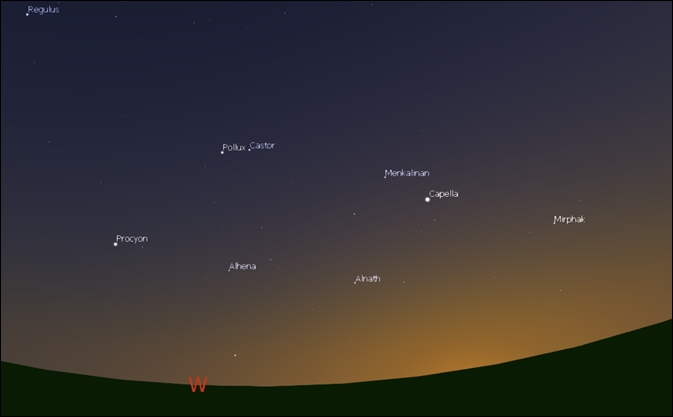 | Great Winter Sky's stars are seen West by twilight! picture site 'Amateur Astronomy' based upon Stellarium |
Wwd A curiosity, the Ariétides shooting stars active late May-early July as they are daytime meteors! more
1 UsA EuA First quartered Moon by all latitudes, is close to Regulus, the bright star to constellation Leo, the Lion tonight!
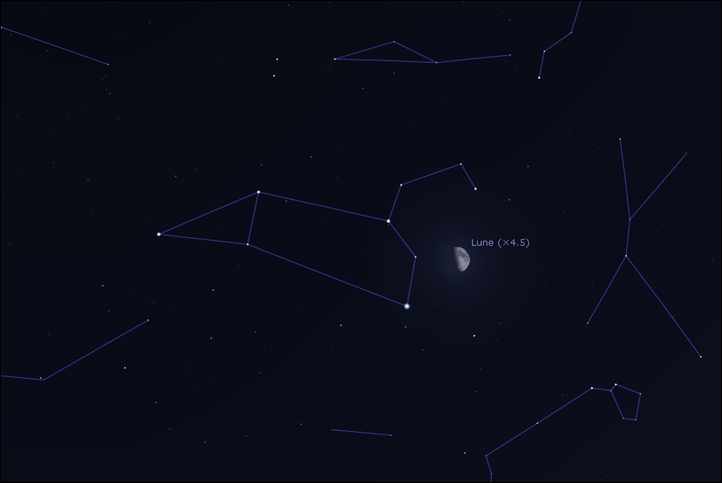 | Moon close to Regulus, the bright star to constellation Leo, the Lion! picture site 'Amateur Astronomy' based upon the Stellarium software |
5 Wwd The Eta Aquarids shooting stars are usually active Apr. 19-May 28, and usually are peaking May 5-6. One of the main shower in the year they are active April 19-May 28 check more back
6 Wwd Moon is at its perigee at 03:03 UT (distances non available)
10 Wwd Moon is at a descending node at 09:01 UT
11 (1) EuA AsP Tomorrow morning and next day also, at all latitudes, waning gibbous Moon is seen close to both Jupiter and Saturn by dawn! Fine views! The show is seen on the first day only for the USA-Americas area
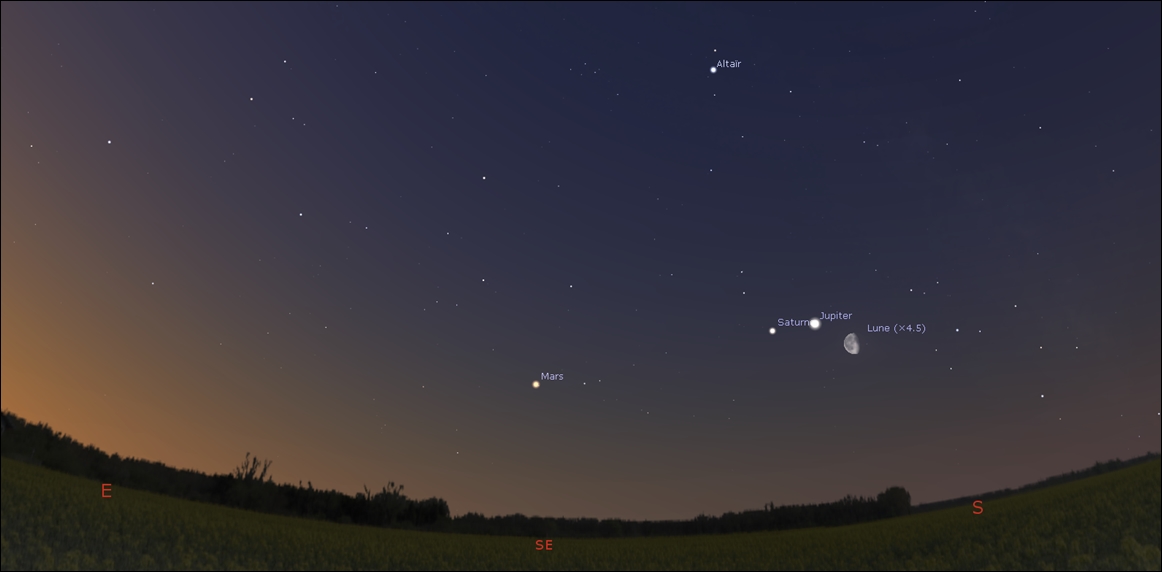 | Moon finely close to Jupiter and Saturn by dawn! picture site 'Amateur Astronomy' based upon the Stellarium software |
11 (2) Wwd Moon reaches a southernmost declination at 06:13 UT
14 Wwd Tomorrow morning by dawn, by all latitudes, Last Quarter is close to Mars! Fine views!
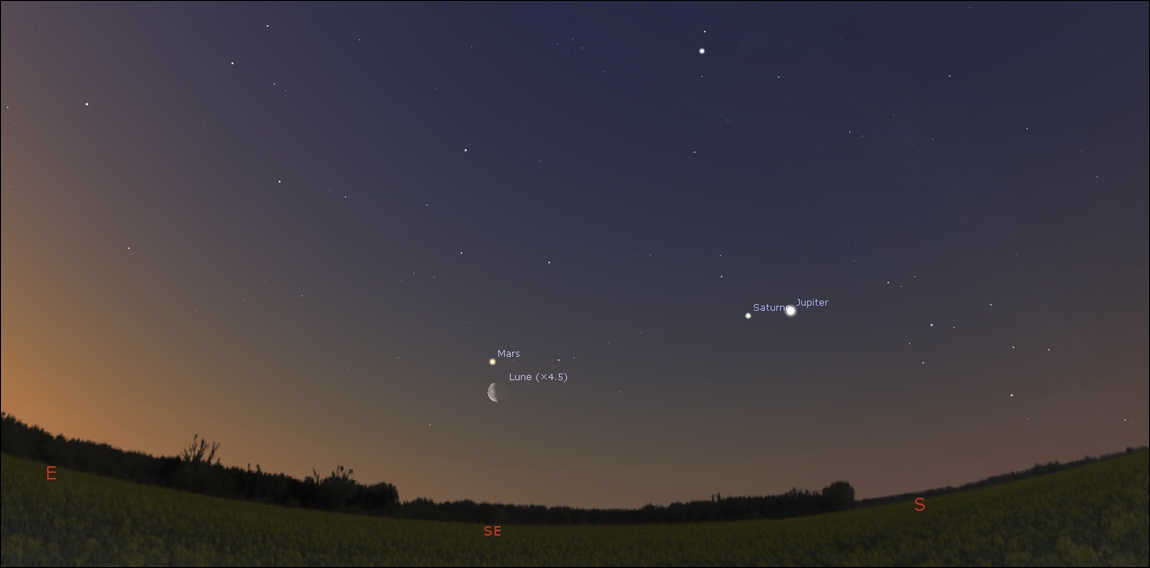 | Moon close to Mars in the morning twilight! picture site 'Amateur Astronomy' based upon the Stellarium software |
18 Wwd Moon is at its apogee at 07:45 UT (distances non available)
24 (1) Wwd Very first crescent at all latitudes, worth the seach by twilight as it's lying close both to Mercury and Venus evening stars. The show may be too low for certain locations. Worth the visual and photographic observation!
 | Moon now close to Venus and Mercury evening stars! picture site 'Amateur Astronomy' based upon the Stellarium software |
24 (2) Wwd There is a occultation of minor planet Vesta today by Moon! check more at Occultations; check more too at such sites like "The International Occultation Timing Association" (I.O.T.A.)
24 (3) Wwd Moon is at a ascending node at 21:34 UT
25 Wwd Moon reaches a northernmost declination at 21:16 UT
29 EuA AsP First quartered Moon at all latitudes, again close to Regulus, the bright star to constellation Leo, the Lion tonight!
Occultations observers are advised to turn to such dedicated sites like the I.O.T.A as they may also check below at our Occultation section
Full Moon is on May 7th, at 10:45 UT
Last Quarter is on May 14th, at 14:03 UT
New Moon is on May 22nd, at 17:39 UT
First Quarter is on May 30th, at 03:30 UT
(source: ephemeris generator at Fred Espenak's NASA's eclipse website)
for what a remarkable configuration of a planet is, check our tutorial 'Planets Apparent Motion'
Mercury is reaching a superior conjunction on May 4th, 2020 at 21:22. Mercury at the Tropics and the southern hemisphere is performing a mean show only as the swift planet is worth the observation in the northern hemisphere as May is unfolding
 | Mercury observable in the northern hemisphere!. picture site 'Amateur Astronomy' based upon the Celestia software |
Venus is now bound to a inferior conjonction next June. Venus is now tending low like a evening star in the northern hemisphere and visible into the night, the same at the Tropics but Venus is about not seen into the night. Venus, in the southern hemisphere is much low northwest
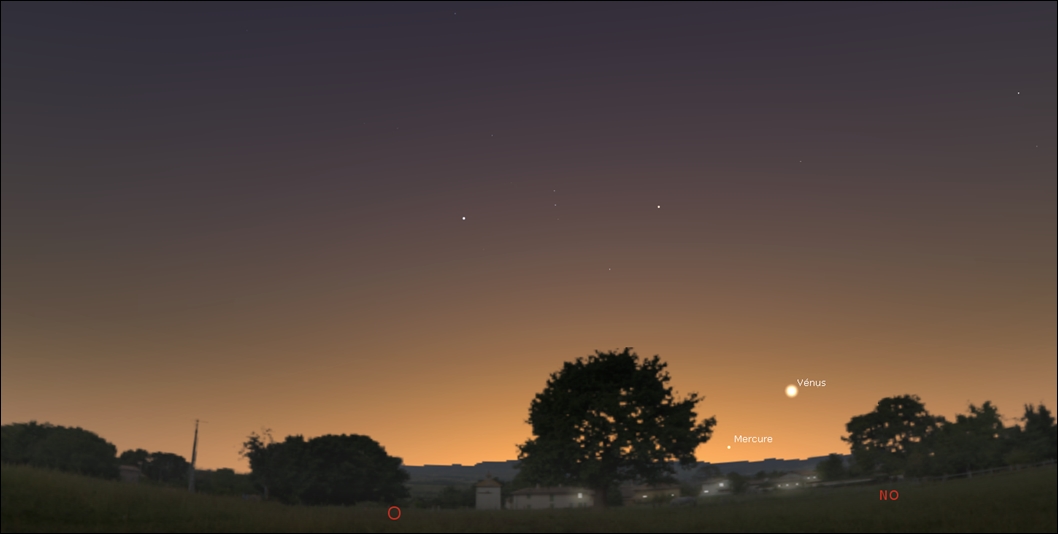 | Venus low like a evening star in the southern hemisphere!. picture site 'Amateur Astronomy' based upon the Stellarium software |
Mars Mars Observation Campaign! is now a fine morning star, southeast, in the northern hemisphere and seen as soon as by late night. At the Tropics, Mars may not qualify like a morning star and rising as soon as by 1:25 a.m. local time. Ditto in the southern hemisphere as Mars is rising by 1 a.m. local time. A Mars observation campaign, the Mars Observation Campaign 2020-2021 is unfolding from March 19th, 2020 when Mars will reach 6" of apparent diameter, until March 10th, 2021 when Mars will be back to that value, a value afficionados deem the least observable. check more at our Mars Observation Campaign 2020-2021 page
 | Mars by May 2020!. picture site 'Amateur Astronomy' based upon the Celestia software |
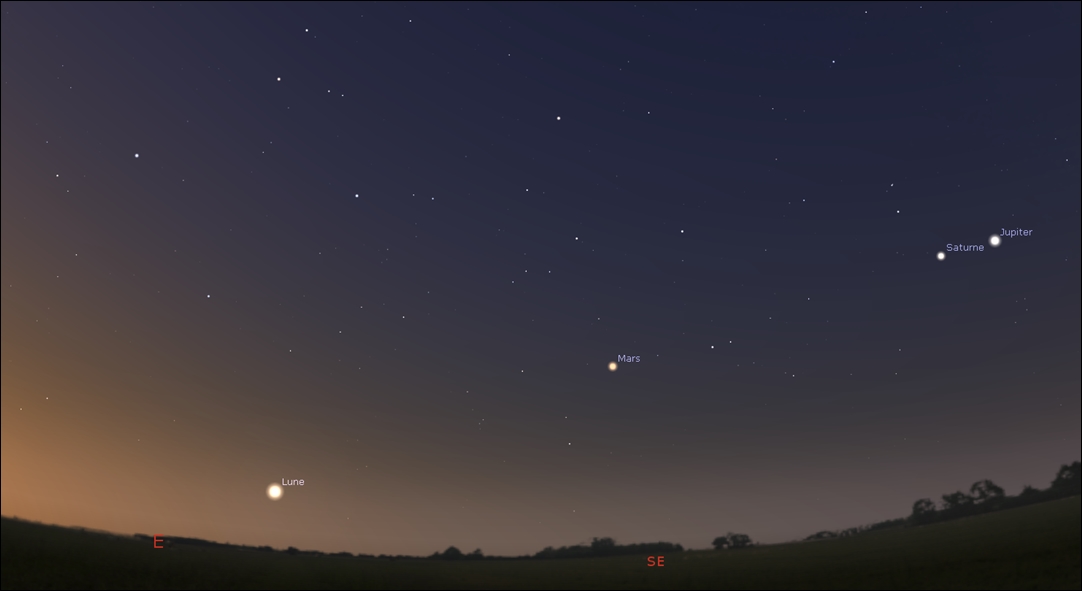 | Mars a morning star in the northern hemisphere!. picture site 'Amateur Astronomy' based upon the Stellarium software |
Jupiter is now rising by about 1:25 a.m. local time in the northern hemisphere, 11:15 a.m. at the Tropics or 10:25 a.m. in the southern hemisphere. Jupiter is seen by dawn in the northern hemisphere
Saturn is now rising by about 1:25 a.m. local time in the northern hemisphere, 11:15 a.m. at the Tropics or 10:25 a.m. in the southern hemisphere. Saturn is seen by dawn in the northern hemisphere. Following a ring aperture maximum, rings now are closing
Uranus after a conjunction last month is not reappearing sufficiently high in the morning sky worldwide
Neptune is rising now by 3:50 a.m. in the northern hemisphere, and observable, 2:34 a.m. at the Tropics or 3:30 a.m. in the southern hemisphere
Pluto is now rising by about 1:25 a.m. local time in the northern hemisphere, 11:15 a.m. at the Tropics or 10:25 a.m. in the southern hemisphere. Hence the faraway world is observable worldwide (according to the International Astronomical Union (IAU) since 2006, Pluto is not considered a planet anymore, but categorized like a dwarf planet instead along with Ceres, Eris, Makemake, and Haumea, and the prototype of a new category of 'trans-Neptunian', 'Pluto-class' objects)
 | Pluto now back to observable worldwide!. picture site 'Amateur Astronomy' based upon the Celestia software |
Minor planets are those biggest asteroids in the Asteroid Belt which may be easily observed by amateurs from the Earth, namely Ceres, Pallas, Juno, and Vesta (due to the new categorization by the International Astronomical Union (IAU) by 2006, Ceres belongs to the 5 dwarf planets in the solar system with Pluto, Eris, Makemake, and Haumea). check data and charts at our section Minor Planets on the yearly Calendar page as our tutorial 'Asteroids and Asteroid Hunting' is of help too. Any remarkable event linked to a minor planet may have a notice here below
Some small asteroids dubbed Near-Earth Objects (NEOs) are regularly making close approaches at Earth. People interested in such close approaches may obtain recent and upcoming data at NASA (JPL) site Center for Near Earth Object Studies (CNEOS) (their section "Close Approaches"). Miscellaneous data are available. For further observational purposes, check at their ephemeris Generator (via Tools/Neo DB Query)
. For more about NEOs see tutorial "
Once every time, the solar system treats us with a remarkable comet, a eery view spanning up to thirty degrees of sky! Most of the time however comets are the domain of dedicated observers as mostly weak and, at the most, hovering at the limit of the naked-eye visibility. A good site to get information about current such comets is the British Astronomical Association Comet Section page or also the Weekly Information about Bright Comets page (which often points to comets close to the visual magnitude). Our 'Comets and Comet Hunting' tutorial will also be helpful. Remarkable comets otherwise usually will be presented below!
 A 6.7th-magnitude comet in the evening sky, for the northern hemisphere and the Tropics!
A 6.7th-magnitude comet in the evening sky, for the northern hemisphere and the Tropics!
Comet C/2019 Y4 will adorn the evening sky in the northern hemisphere and the Tropics as it will reach the 6.7th magnitude by April. It moves from the Giraffe to Aldebaran via Perseus. In the northern hemisphere thus C/2019 Y4 will be visible after dusk, in the Giraffe, between West and northwest in April, ditto in the tropics, lower. In the southern hemisphere the comet will unfortunately not be visible. Comet C/2019 Y4 by May will keep moving South into Perseus as lower it will also be lighter (about the 2nd magnitude. by the Tropics, C/2019 Y4 will be lower still). Binoculars or a small telescope will be a good choice to spot the comet C/2019 Y4. click on a map of comet C/2019 Y4's motion (between Apr. 1-3O/2020, 1 day in 1 day, with magnitude, for 0h UT). The green hue of C/2019 Y4 is due to the cyanogen it contains and which becomes fluorescent because it is bombarded by sunlight's ultraviolet. C/2019 Y4 was last seen in the solar system at the time of the Great Pyramids of Egypt, in the 4th millennium BC. On May 27, it will pass as close as possible to Earth at 73 million miles and on May 31 it will be at its perihelion, by 24 million miles from the Sun
UPDATED! 2019 Y4 (ATLAS) brightening had stopped due to a major disruption event beginning by early April, on a sequel of something begun about mid-March! It looks like a remnant nucleus produced its own coma, and brightening however. No hope now for better as 2019 Y4 is fading to the 8th and 9th magnitude! On the other hand, we won't update about the new C/2020 F8 (SWAN) comet which is said siding to the 6th magnitude
->note: shooting stars afficionados will be aware of checking Moon at the dates of the showers
for more about the meteor showers of this month, for possible other meteor showers for this month, and for more about shooting stars, generally, see our tutorial "Shooting Stars"
Each month, Moon occults some relatively bright stars, that is the Moon, beginning either with its bright or its dark visible face, is passing in front of a star. This is called an occultation. The Pleiades, on the other hand, due to their position near the eclipic, are often occulted by Moon too. Some planets, at last, along the year, may be occulted by Moon or they themselves, or their satellites, may be seen too occulting a star. The asteroids too may occult stars. Yearly lists of such phenomenons are to be found at Sky & Telescope/SkyTonight.com, either in their newsstand issues or at their site, as a list of occultations of most brilliant stars, the planets and the Pleiades are available at the I.O.T.A site (I.O.T.A. stands for "The International Occultation Timing Association"). Most notable occultations are signaled below. Are given here only planetary occultations; for bright stars occultations, check at such sites like "The International Occultation Timing Association" (I.O.T.A.)
Minor planet Vesta back is occulted by Moon on May 24th, 2020 by 15:00 UT! The show is available for Most of North America(except western coast,Alaska and north westernCanada), northern Caribbean,Greenland, most of Europe(except southernmost parts),western Russia, northernMiddle East. check more at such sites like "The International Occultation Timing Association" (I.O.T.A.)
check on this site for more about occultations, theoretically
| CAUTION! OBSERVING THE SUN IS DANGEROUS AND REQUIRES DEDICATED SAFE TECHNIQUES! |